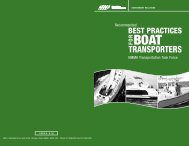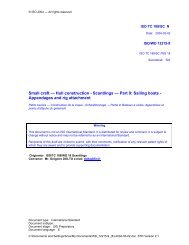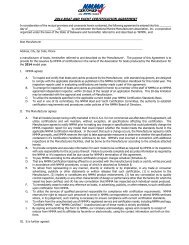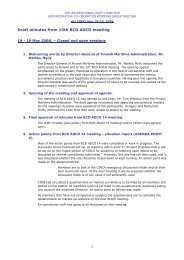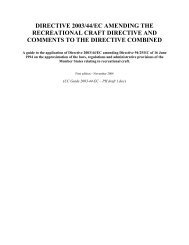global environmental legislation guide - National Marine ...
global environmental legislation guide - National Marine ...
global environmental legislation guide - National Marine ...
You also want an ePaper? Increase the reach of your titles
YUMPU automatically turns print PDFs into web optimized ePapers that Google loves.
4. DNV: Notation for underwater noise (in coordination with IMO and as an example)A low underwater noise level is an essential design feature for the operation of certain shiptypes as well as when operating in <strong>environmental</strong>ly sensitive areas. On 1 January 2010, thefirst ever notation of underwater noise was published by Det Noske Veritas (DNV).Particularly operators of offshore survey vessels, fishery research vessels, ocean researchvessels, seismic vessels, fishing vessels and military vessels have noticed increased problemsdue to sound masking resulting from underwater noise. Such vessels are extremely sensitiveto underwater noise radiation because a high noise level will directly interfere with theiroperational ability. Research vessels employ hydro acoustic sensors to perform their worktasks as fishing and fishery research vessels depend on not scaring away the fish, luxuryyachts and cruise vessels require a high degree of personal comfort and military vessels needto operate undetected and avoid triggering of mines.Obviously, noise control will have to be given high priority throughout the design andconstruction phases of the vessels mentioned above. From an <strong>environmental</strong> point of view,the <strong>Marine</strong> Environmental Protection Committee (MEPC) of the International MaritimeOrganization (IMO) stated in July 2009: “The committee urges governments to review theircommercial fleets to identify the ships that contribute most to underwater noise pollution”.At the same time, the International Fund for Animal Welfare (IFAW) estimates that thenoisiest 10% of ships contribute the most to the noise problem.DNV explains that an efficient noise and vibration control can be integrated in vessel designwithout increasing building costs significantly. It identifies the propellers to usually be thenumber one source for noise. Radiation of structure borne noise is identified as the second.The new optional class notation by DNV covers a complete set of criteria and rules forverification and is intended to ensure operational capability for four different types of ships.It is divided into five sub-notations:Acoustic (A)Requirements for vessels using hydro-acoustic equipment as an important tool in theiroperation, e.g. survey vessels, ocean research vessels, pipe layers, diving vessels, variousoffshore support vessels etc.Seismic (S)Vessels towing heavy streamers and airguns and therefore have a high demand onpropulsion power.Fishery (F)The requirement is not to scare the catch away.Research (R)Requirement based on the existing ICES 209, however with a low frequency modification.This is an extremely demanding criteria requiring “submarine” type technology.Environmental (E)Environmentally conscious owners may demonstrate <strong>environmental</strong> compliance through the“Environment Notation”. This voluntary class requirement, which comes in the two levelscalled “Transit” and “Passage”, will achieved without increasing costs significantly. They willonly require engineering advice with regards to the propeller design and propulsion.45



